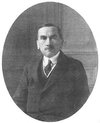Second Polish Republic
|
|
Rzeczpospolita_1920.png
The Second Polish Republic is an unofficial name applied to the Republic of Poland between World War I and World War II. When the borders of the state were fixed in 1921, it had an area of 388.6 thousand sq. km. (sixth largest in Europe), and 27.2 million inhabitants according to the census of that year. In 1939, just before the outbreak of World War II, it had an estimated 35.1 million inhabitants. A third of these were national minorities (10% Jews, 17% Ukrainians and Belarusians, 5% Germans, and 1% percent Lithuanians, Russians and Czechs).
| Contents |
History
Main article: History of Poland (1914-1939)
Occupied by German and Austro-Hungarian armies in the summer of 1915, the formerly Russian-ruled part of Poland was proclaimed an independent kingdom by the occupying powers on November 5, 1916, with a governing Council of State and (from October 15, 1917) a Regency Council (Rada Regencyjna Królestwa Polskiego) to administer the country under German auspices pending the election of a king.
Shortly before the end of World War I, on October 7, 1918, the Regency Council dissolved the Council of State and announced its intention to restore Polish independence. With the notable exception of the Marxist-oriented Social Democratic Party of the Kingdom of Poland and Lithuania (SDKPiL), most political parties supported this move. On October 23 the Council appointed a new government under Józef Swierzynski and began conscription into the Polish Army.
On November 5, in Lublin, the first Soviet of Delegates was created. On November 6 the Communists announced the creation of a Republic of Tarnobrzeg. The same day, a Provisional People's Government of the Republic of Poland was created under the Socialist, Ignacy Daszynski.
Powstancy_Wlkp.jpg
Elections to the Sejm: January 26, 1919. On November 10, Józef Piłsudski, newly freed from imprisonment by the German authorities at Magdeburg, returned to Warsaw. Next day, due to his popularity and support from most political parties, the Regency Council appointed Piłsudski Commander in Chief of the Polish Armed Forces. On November 14 the Council dissolved itself and transferred all its authority to Piłsudski as Chief of State (Naczelnik Państwa).
Polish-soviet_war_1920_Aftermath_of_Battle_of_Warsaw.jpg
Centers of government that were created in Galicia (formerly Austrian-ruled southern Poland) included a National Council of the Principality of Cieszyn (created on November 19) and a Polish Liquidation Committee (created on October 28). Soon afterward, conflict broke out in Lviv (Polish Lwów) between forces of the Military Committee of Ukrainians and the Polish "Eagles" of Lwów.
After consultation with Pilsudski, Daszynski's government dissolved itself and a new government was created under Jedrzej Moraczewski.
Armoured_Car_Korfanty_1920.jpg
War against the Ukrainians: Polish-Ukrainian War. War against the Soviets: Polish-Soviet War. Miracle of the Vistula. Treaty of Riga. War against the Lithuanians: Polish-Lithuanian War. Border conflicts between Poland and Czechoslovakia.
Uprisings in Wielkopolska and Silesia. Great Poland Uprising, Silesian Uprisings.
July 15, 1920 - Agrarian Reform.
March 17, 1921 - March Constitution. 1921 - alliances with France, Romania.
Election to Sejm and Senat - November 1922.
President Gabriel Narutowicz, and his assassination (December 16, 1922).
1924 - Wladyslaw Grabski Government. Bank Polski. Monetary reform.
President Wojciechowski - December 20, 1922, to Zamach majowy.
Coup of May - Zamach majowy, 1926, May, Józef Piłsudski coup d'etat (May Coup). beginning of Sanacja government.
Roman Dmowski, Obóz Wielkiej Polski (4 December 1926), Endecja.
Rydz_Smigly_Bulawa1.jpg
16 November 1930 - wybory brzeskie (elections
25 July 1932 - non-aggression pact with Soviet Union
26 January 1934 - non-violence ? pact with Germany
14 April 1934 - Obóz Narodowo-Radykalny
23 April 1935 - April Constitution
12 May 1935 - death of Józef Piłsudski
WWII_Poland_Invasion_1939-09-01.jpg
Gdynia, Centralny Okreg Przemyslowy (1936), Eugeniusz Kwiatkowski
2 February 1937 - Obóz Zjednoczenia Narodowego
2 January 1939 - death of Roman Dmowski
31 March 1939 - military guarantees from United Kingdom and France
23 August 1939 - allience between Soviet Union and Germany: Ribbentrop-Molotow Pact
25 August 1939 - alliance between Poland and United Kingdom
Polish September Campaign - the beginning of the Second World War and end of the Second Polish Republic. succeeded by Polish Government in Exile.
Politics and government
Economy
Culture
Geography and demographics
Main article: Voivodships of Poland
Poland_administrative_division_1922_literki.png
| Polish voivodships in the interbellum (data as per April 1, 1937) | |||||
| car plates (since 1937) | Voivodship Separate city | Capital | Area in 1000 km² (1930) | Population in 1000 (1931) | |
|---|---|---|---|---|---|
| 00-19 | City of Warsaw | Warsaw | 0,14 | 1179,5 | |
| 85-89 | warszawskie | Warsaw | 31,7 | 2460,9 | |
| 20-24 | białostockie | Białystok | 26,0 | 1263,3 | |
| 25-29 | kieleckie | Kielce | 22,2 | 2671,0 | |
| 30-34 | krakowskie | Kraków | 17,6 | 2300,1 | |
| 35-39 | lubelskie | Lublin | 26,6 | 2116,2 | |
| 40-44 | lwowskie | Lwów | 28,4 | 3126,3 | |
| 45-49 | łódzkie | Łódź | 20,4 | 2650,1 | |
| 50-54 | nowogródzkie | Nowogródek | 23,0 | 1057,2 | |
| 55-59 | poleskie | Brześć nad Bugiem | 36,7 | 1132,2 | |
| 60-64 | pomorskie | Toruń | 25,7 | 1884,4 | |
| 65-69 | poznańskie | Poznań | 28,1 | 2339,6 | |
| 70-74 | stanisławowskie | Stanisławów | 16,9 | 1480,3 | |
| 75-79 ? | śląskie | Katowice | 5,1 | 1533,5 | |
| 80-84 | tarnopolskie | Tarnopol | 16,5 | 1600,4 | |
| 90-94 | wileńskie | Wilno | 29,0 | 1276,0 | |
| 95-99 | wołyńskie | Łuck | 35,7 | 2085,6 | |
See also
pl:Druga Rzeczpospolita (1918-1939) pt:Segunda República Polaca ro:A doua Republică Poloneză

